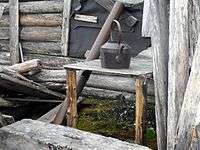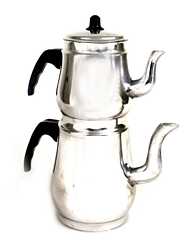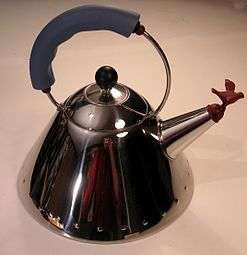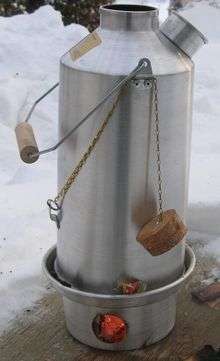Kettle

A kettle, sometimes called a tea kettle or teakettle is a type of pot, typically metal, specialized for boiling water, with a lid, spout and handle, or a small kitchen appliance of similar shape that functions in a self-contained manner. Kettles can be heated either by placing on a stove, or by their own internal electric heating element in the appliance versions.
History

The first kettles were used in ancient Mesopotamia for purposes other than cooking. Over time these artistically decorated earthenware containers became more frequently utilized in the kitchen. In China, kettles were typically made of iron and were placed directly over an open flame. Travellers used the kettles to boil fresh water to make it suitable for drinking.
The word kettle originates from Old Norse ketill "cauldron". The Old English spelling was cetel with initial che- [t?] like 'cherry', Middle English (and dialectal) was chetel, both come (together with German Kessel "cauldron") ultimately from Germanic *katilaz, that was borrowed from Latin catillus, diminutive form of catinus "deep vessel for serving or cooking food",[1] which in various contexts is translated as "bowl", "deep dish", or "funnel".
The development of kettles was in direct correlation with the evolution of the modern stove.[2]
Electric kettle

In the latter part of the 19th century, electric kettles were introduced as an alternative to stove top kettles. In 1893 the Crompton and Co. firm in the United Kingdom started featuring electric kettles in their catalogue. The early electric kettles were quite primitive as the heating element couldn't be immersed in the water. Instead, a separate compartment underneath the water storage area in the kettle was used to house the electric heating element. The design was inefficient even relative to the conventional stove-top kettles of the time.
In 1922, the problem was finally solved by Leslie Large, an engineer working at Bulpitt & Sons of Birmingham who designed an element of wire wound around a core and sheathed in a metal tube. As this element could be immersed directly into the water it made the new electric kettle much more efficient than stovetop kettles.[3][4]
In 1955, the newly founded British company Russell Hobbs brought out its stainless steel K1 model as the first fully automatic kettle. A thermostat, triggered by the rising steam as the water would come to boil, would flex, thereby cutting off the current.[5][6]
Modern kettles include a variety of technological advancements. Some electric kettles are cordless with illumination capabilities. Whistling kettles emit an audible sound as the water boils.
Stovetop kettles
A stovetop kettle is a roughly pitcher-shaped metal vessel used to heat water on a stovetop or hob. Kettles usually have a handle on top, a spout, and a lid. Sometimes stove-mounted kettles also have a steam whistle that indicates when the water has reached boiling point. In whistling tea kettles, when the steam building up in the container of the kettle tries to escape, it causes vibrations to occur within the chamber. As the speed of the releasing steam increases, the vibrations become louder, causing a whistle. Some whistling kettles have an actual whistle on a cover at the end of the spout.
The most popular stovetop kettles are made with stainless steel. This is due to the lightweight nature of the kettle, in addition to the bright finish and durability. The crack-resistant nature of the kettle also makes it easier to clean. Kettles can also be made from copper, iron, aluminum, polished chrome or ceramic.
A kettle has two principal advantages over a saucepan for heating water: the enclosed nature of a kettle reduces heat losses and leads to quicker boiling, and the exclusive use of the kettle for water means that hot drinks cannot be contaminated by grease spots or food residues left if saucepans are not meticulously washed.
Electric kettles
Electric kettles were introduced as a means to boil water without the necessity of a stove top. They are normally constructed of durable plastic or steel (with a plastic handle) and powered by mains electricity. In modern kettles the heating element is typically fully enclosed, with a power rating of 2 - 3 kW at 220V. In countries with 110V mains electricity, kettles may be less powerful to avoid drawing too much current and requiring a very thick supply wire.
In modern designs, once the water has reached boiling point, the kettle automatically deactivates, preventing the water from boiling away and damaging the heating element. A bimetallic strip thermostat is commonly used as the automatic shut-off mechanism.[7] The thermostat is isolated from the water in the kettle and is instead heated by the steam created when the water boils, which is directed through a duct onto the bimetallic strip. This allows the thermostat to be coarsely calibrated, which in turn allows the kettle to function normally at a wide range of altitudes. A consequence of this design is that the kettle may fail to deactivate if the lid is left open, due to an insufficient amount of steam being ducted onto the bimetallic strip.
Jug kettles became popular in the late 20th century. They have a more upright design and are more economical to use, since small amounts of water, enough for only one cup, can be boiled while still keeping the element covered.
In the United States an electric kettle may sometimes be referred to as a hot pot.
Kettle gallery
 Aluminium çaydanlık. A unique instrument of Turkish cuisine.
Aluminium çaydanlık. A unique instrument of Turkish cuisine.- Kettle on a portable stove at the Museu da Baronesa, Brazil

 Graves kettle, 1984, a post-modern kettle with a bird-shaped whistle on the spout
Graves kettle, 1984, a post-modern kettle with a bird-shaped whistle on the spout- A contemporary electric kettle made from enameled metal and plastic
 Industrial-scale copper kettles used in a beer brewery
Industrial-scale copper kettles used in a beer brewery Solar powered kettle
Solar powered kettle A Kelly kettle, designed to efficiently use the heat of a small fire in a chamber at the base
A Kelly kettle, designed to efficiently use the heat of a small fire in a chamber at the base
Similar devices
- A cauldron is a large kettle hung over an open fire, usually on an arc-shaped hanger called a bail.
- A fish kettle is a long slim metal cooking vessel with a tight fitting lid to enable cooking of whole large fish such as salmon.
- A kettle grill is a dome shaped grill with a rounded lid, resembling a cauldron.
- A kettle drum is a kettle (cauldron) shaped drum.
See also
- Kelly Kettle, specialized types of kettles for outdoor use, intended to use fuel more efficiently
- Samovar, a type of urn used for boiling water and making tea in Russia and other parts of eastern Europe
- Tea culture
- Teapot, a vessel with spout, lid, and handle, often ceramic, for brewing and serving tea with water that has been previously boiled
- Teasmade, an English appliance that combined a kettle and a teapot to make tea automatically by a clock
- Tetsubin, a cast iron Japanese pot with a spout
- Windermere kettle
References
- ↑ T. F. Hoad, English Etymology, Oxford University Press, 1993 (ISBN 0-19-283098-8). p. 252.
- ↑ "Electric Tea Kettle". MadeHow.com. Retrieved 30 July 2012.
- ↑ "Electric Kettles". The Memory Store. John Lewis Partnership. Retrieved 2013-06-24.
- ↑ "Small Appliances". The Association of Manufacturers of Domestic Appliances. Retrieved 2013-06-24.
- ↑ "Made in the UK: The life-changing everyday innovations which put British genius on the map".
- ↑ "Electric Kettles" (PDF). Museum of Science and Industry.
- ↑ How Does The Switching System Turn Off An Electric Kettle When It Boils?, Blurtit.com. Retrieved 3 April 2013.
Further reading
- Stevenson, Seth (Nov. 8, 2005). "A Watched Pot". Slate.
- Copeland, Paul L. (2000). Engineering Studies: The Definitive Guide. Allawah, New South Wales: Anno Domini. ISBN 9780646394596.
External links
| Wikimedia Commons has media related to Kettles. |